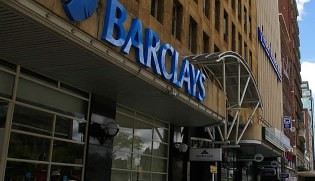
Barclay's bank worker's union in Zimbabwe to hold pickets across the country., a photo by Pan-African News Wire File Photos on Flickr.
Banks can’t self-regulate
January 16, 2014
Sibanda Senior Business Reporter
Zimbabwe Herald
BANKS continue to make the bulk of their income from fees and charges as opposed to the core business of lending money in what significantly eats into the banking public’s hard earned cash. According to financial analysts, the majority of banks mostly smaller ones with low capital make between 40 percent and 60 percent of their income exclusively from fees and commissions.
The Reserve Bank of Zimbabwe once had a Memorandum of Understanding with banks meant to rein in unfettered increases in fees and commission charges that significantly ate into depositors’ funds.
The MoU, which came into effect on February 1 2013, required, among other things, that lending rates be capped at 12,5 percent, above each respective bank’s weighted average cost of funds.
Banks were also persuaded to charge up to 0,5 percent of cash withdrawals after a minimum charge of US$2,50 while ledger fees, maintenance and service fees cost up to US$4 per account.
The RBZ and banks also agreed to push for the mandatory use of debit cards. This was because the issue of high bank charges had became so topical that fiscal and monetary authorities at one point contemplated legislating the rates and fees to curtail punitive increases.
However, the RBZ late last year announced that it would not be renewing the MoU hoping that banks would maintain lower charges, but ostensibly, nothing had changed in their behaviour.
In a letter to the Bankers Association of Zimbabwe, ex-RBZ Governor Dr Gideon Gono said after reviewing the operating environment, the broader circumstances in the wider economy as well as representations from the bankers, the central bank would not seek to renew the MoU.
It must, however, be noted that this came about after the banks strongly lobbied against the cap on charges saying it ate significantly and into their profits and threatened the viability of their operations.
After deciding against renewing the MoU, Dr Gono “advised (banks) to continue offering affordable banking services to the public in order to spur financial inclusion initiatives already in place.”
But the big question remains “do financial institutions understand the language of moral suasion?”
From past experiences, it seems banks only understand the language of “profit at all costs”.
The scenario lends credence to the ex-governor’s strong belief that if banks maintained reasonable levels of capital they would be able to increase volumes and spread costs hence charge less.
That would also enable the financial institutions to engender more confidence in the public regarding the safety of their money as well as to leverage their balance sheets for lines of credit.
It is against this background that Dr Gono actively pushed for phased minimum capital increases until the financial institutions, especially commercial banks, attained US$100 million.
Surely, while banks must make profit as expected of businesses by levying economic charges, it seems most want to attain profitability simply through high charges rather than innovative products.
Surviving the tide on the liquidity induced viability challenges should ideally not be just through fleecing vulnerable depositors, but also be achieved through ethical and innovative business practices.
In sectors such as retail, prices of goods have remained stable because retailers sacrificed short-term benefits by foregoing profits “at whatever cost’ but sought strategies to ensure survival.
But considering the fact that banks appear reluctant to keep charges to an absolute minimum or within an economically sensible range it seems that, a framework to guide them is critical.
To that end, financial analysts said monetary authorities need to re-introduce the framework that provides guidelines to the banking institutions in terms of pegging the commissions and fees.
It should be noted that the outcry from the banking public due to the high cost of banking charges does not augur well for confidence building so badly needed in the financial services sector.
Confidence in the sector suffered heavy battering at the height of Zimbabwe’s economic instability up to 2008 when people battled to obtain their cash from banks while inflation ravaged its value.
Distrust in banks was further compounded by the fact that after local currency was replaced by a basket of foreign currencies; people are still to get the equivalent of their local unit’s bank balances.
That lack of confidence has often been cited as the reason behind the slow growth in bank deposits because potential bank customers find it cheaper to keep their money in their homes.
An estimated US$2 billion to US$4 billion is believed to be circulating outside the formal banking sector, which could significantly help fund productive sectors if it found its way into the banks.
Besides the high cost of opening and maintaining, banks have not been offering attractive incentives to the banking public in the form of interest on deposits, rather the balance fall due to charges.
No comments:
Post a Comment